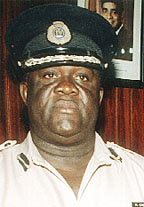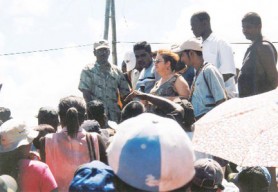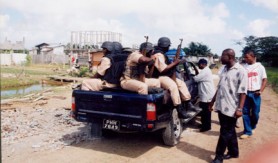Corruption and criminality inside the Guyana Police Force are becoming worse
Corruption has cast a long shadow over the Guyana Police Force and a series of serious scandals have scarred its reputation of over the years. By failing to punish the malefactors, the Force has allowed the problems to fester.

Several senior Police officers were implicated in one of this country’s earliest and largest people-trafficking (‘back-track’) schemes. The Royal Canadian Mounted Police arrested and charged Guyana-born Shawn Baldeo in Canada, alleging that he had smuggled hundreds of Guyanese into Canada in 1993. The RCMP made tape recordings of telephone conversations implicating local police officers with the Baldeo organisation. No one was ever punished in Guyana.
Several senior Police officers were again implicated in one of the worst corruption scandals in the US Diplomatic Service, in 2000. The United States diplomat Thomas Carroll was arrested with Guyana-born Halim Khan on charges of conspiracy to commit bribery and visa fraud. Although Carroll and Khan both served custodial sentences for their crimes in the USA, the police officers were never punished in Guyana.
Several serving policemen, usually from the Police Force’s dreaded Target Special Squad, were known to accompany the notorious drug-trafficker Shaheed ‘Roger’ Khan. When he was arrested by a Guyana Defence Force patrol in the area of Good Hope, East Coast Demerara in December 2002 with a vehicle which contained an arsenal of weapons and other equipment, Khan had a serving member of the Police Force at his side. A magistrate dismissed the charges against them and no internal action was taken against the policeman.
More than any other factors that have impaired the performance of the Police Force, corruption and misconduct have worsened at a time when countering transnational crime demanded greater integrity and efficiency. The increased incidence of narco-trafficking, money-laundering, gun-running and contraband-smuggling has made criminals richer and more capable of bribing poorly-paid police officers. Members of the public are usually the first to feel the effects of police misconduct. Occasionally, they have taken to the streets to call public attention to well-known grievances.

On one such occasion, hundreds of angry demonstrators assaulted the Minister of Home Affairs Ronald Gajraj, burnt a magistrate’s car, attempted to burn down the Albion Police Station, blocked the roadway bringing traffic to a halt and conducted other acts of public terror at Albion on the Corentyne Coast on June 4 & 5, 2001. A man was shot dead by the police. In the aftermath, however, little was done to correct the abuses about which the protestors complained in the first place.
Disorder erupted again on the Corentyne four years later. Residents of Tain and surrounding communities including Whim, not far from Albion where the previous protest occurred, burnt tyres and old vehicles to protest the alleged corrupt practices of members of the Tactical Service Unit stationed in the Region, on November 25, 2005. This time, it was the job of Minister of Home Affairs Gail Teixeira to placate the restless residents. She sped to the troublespot and gave the usual assurances that there will be a thorough investigation into the allegations which included corruption and collusion with criminal elements by policemen. She promised, “We will set up an investigating committee to take evidence from people who have been victims of police corruption, or victims of suspect police involvement in any criminal activities.”
She promised the protestors that “any police rank found to be guilty of corruption will not remain in the Police Force… The Commissioner of Police and I are serious about lifting the standards of the police and their professionalism so do not doubt our seriousness.” She was wrong.

Apart from everyday corruption, the most egregious misdoings by the police have been extra-judicial killings of persons deemed to be ‘suspects.’ This practice was facilitated by the formation of various quick-reaction squads. The most lethal was called the Target Special Squad which came under the command of Superintendents Leon Fraser and Stephen Merai prior to and during the period of the troubles on the east coast, mainly in 2002-2003. Extra-judicial killings made an immediate and negative impact on families and society and robbed the police of public support.
The United Nations Human Rights Committee had made recommendations to the Government of Guyana for the prompt investigation of police killings and the excessive use of force and for measures to ensure the prosecution of offenders and the provision of effective remedies to victims. The recommendations were ignored largely and public investigations were often not conducted into such killings.
The worst case of police misconduct for several years has been the torture of the boy − Twyon Thomas − at the Leonora Police station on October 28, 2009. There was a short-lived outcry from civil society and citizens rights groups who staged a public protest to demand a higher level of human security and accountability than the force has been accustomed to providing.
The Twyon Thomas torture incident occurred after the murder of People’s Progressive Party former Vice-Chairman of the Essequibo Islands-West Demerara Region Ramnauth Bisram. The torture was a direct consequence of the arrest, detention and torture of suspects by the force’s Criminal Investigation Department. The problem was that this was not the first time that allegations of torture had been levelled against the Guyana Police Force. Officials, including ministers of the government, insensitively dismissed previous reports.
The catalogue of crimes committed by serving policemen seems to grow daily. Commissioner of Police Henry Greene had reported at the end of last year that formal complaints, many for “corrupt practices” against members of the Force, had surged by 11 per cent in 2009 to an average of about one every 48 hours. Even President Bharrat Jagdeo claimed to be astonished at the rate of corruption. He publicly expressed his dismay over the fact that, the last time he spoke to the Commissioner of Police, he was told there were about ninety policemen before the courts. “Ninety policemen in a Force of about 3,000 people… it’s a lot,” the President remarked in disbelief.
While the official mechanisms for examining complaints move slowly, corrupt policemen have continued their misconduct uninterrupted. A police constable was one of three men held for a robbery at Crabwood Creek, Corentyne during which the victim was handcuffed and robbed of cash and jewellery. Three policemen from the Leonora Police Station stole $4.3 million out of $5.8 million which they had retrieved from suspects held for the robbery and murder of a gold dealer in the Essequibo River. A policeman and a merchant were accused of robbing a man at gunpoint of a motor van and several other items totalling $8.3 million. A policeman was charged with demanding money by menace with intent to steal it while he and three other policemen were conducting a stop-and-search exercise. There are many more.
Crimes such as these in the force can no longer be treated as marginal departmental misdemeanours. The manner of investigating them and method of punishing the malefactors require serious remodelling. Corruption and criminal conduct in the force have the capability to trigger a vicious cycle – police corruption corrodes credibility; the lack of credibility paralyses effective law enforcement; the lack of effective law enforcement fosters criminality and police corruption – and so the wheel turns.
Investigation into crimes committed by policemen has become so burdensome that it now provides full-time occupation for two agencies – the Police Complaints Authority and the Guyana Police Force’s Office of Professional Responsibility.
The former is headed by a retired Chancellor of the Judiciary who does not have any investigative capability or resources. He is obliged to refer all complaints against the Police to the Police Commissioner. He must then await the Commissioner’s response before making recommendations. The latter is headed by a retired Assistant Commissioner of Police but he too can investigate only such matters as are referred to him by the Commissioner. The Office is staffed by uniformed policemen who record statements, conduct investigations and refer the matters to the Director of Public Prosecutions for advice.
The facts are that the internal disciplinary mechanism is reactive and that the investigative function is ponderous and highly centralised. The Commissioner is the sole authority for initiating investigations into the misconduct of members of the force. In addition, the benefit of employing retirees to lead these two agencies which require vigorous diligence and independence is questionable.
The slowness and shallowness of the process and sheer volume of complaints clearly have not deterred policemen from their criminal behaviour. The PCA and PSC do not possess the capabilities to conduct independent investigations. These agencies cannot properly investigate, much less prevent, criminality. As a result, abuses have been recurring with frightening frequency.
Minister of Home Affairs Clement Rohee has been one of the most consistent critics of misconduct in the force but he seems to place more faith in remonstrance than reform. Speaking at a ceremony to mark the refurbishment of the Brickdam and East La Penitence police stations last June, he criticised “loose” behaviour at police stations across the country. He told policemen that, based on reports he received on regular basis, “there was too much slackness taking place at stations and that such slackness can put the security of police stations at risk.” On another occasion, Mr Rohee cited allegations of financial impropriety, the mistreatment of prisoners and corrupt practices.
In his review of the performance of the Police Force in 2009, Rohee remarked, “While it is recognised that in any organisation there is every likelihood that a few deviants will find themselves among its staff, I think that the incidents of misconduct involving ranks were too many in 2009 and have to be addressed.”
One of the reasons the epidemic of corruption continues to rage is that its causes have not been understood. The main remedy which has been recommended and on which the administration’s entire policing strategy rests is the creation of a parallel police force made up of community and neighbourhood policing elements.
President Jagdeo visited Tain in December 2005 in the wake of the disorder and made it clear the he wanted the residents to support Government’s initiative to introduce Neighbourhood Policing. This he said is “one of the immediate measures which would alleviate the problem” − the collusion of members of the Police Force in Berbice with criminal elements − which surfaced at Tain.
Ms Teixeira also claimed that “neighbourhood police play an integral role in curbing crime and violence in society and should therefore be encouraged by the various communities to join this fight against crime.” Her successor Mr Rohee iterated from the outset of his tenure that the solution to the personnel problem in the professional Police Force was to expand the neighbourhood policing programme and extend community policing groups.
Police corruption and misconduct have emerged over a long period of time and whether the administration’s nostrums can cure the disease remains to be seen. The conventional view is that criminal conduct within the force festered as a result of years of inappropriate training, inept management and political interference. Until the Guyana Police Force is comprehensively reformed, these abuses will recur.
Desperate diseases require desperate remedies.

